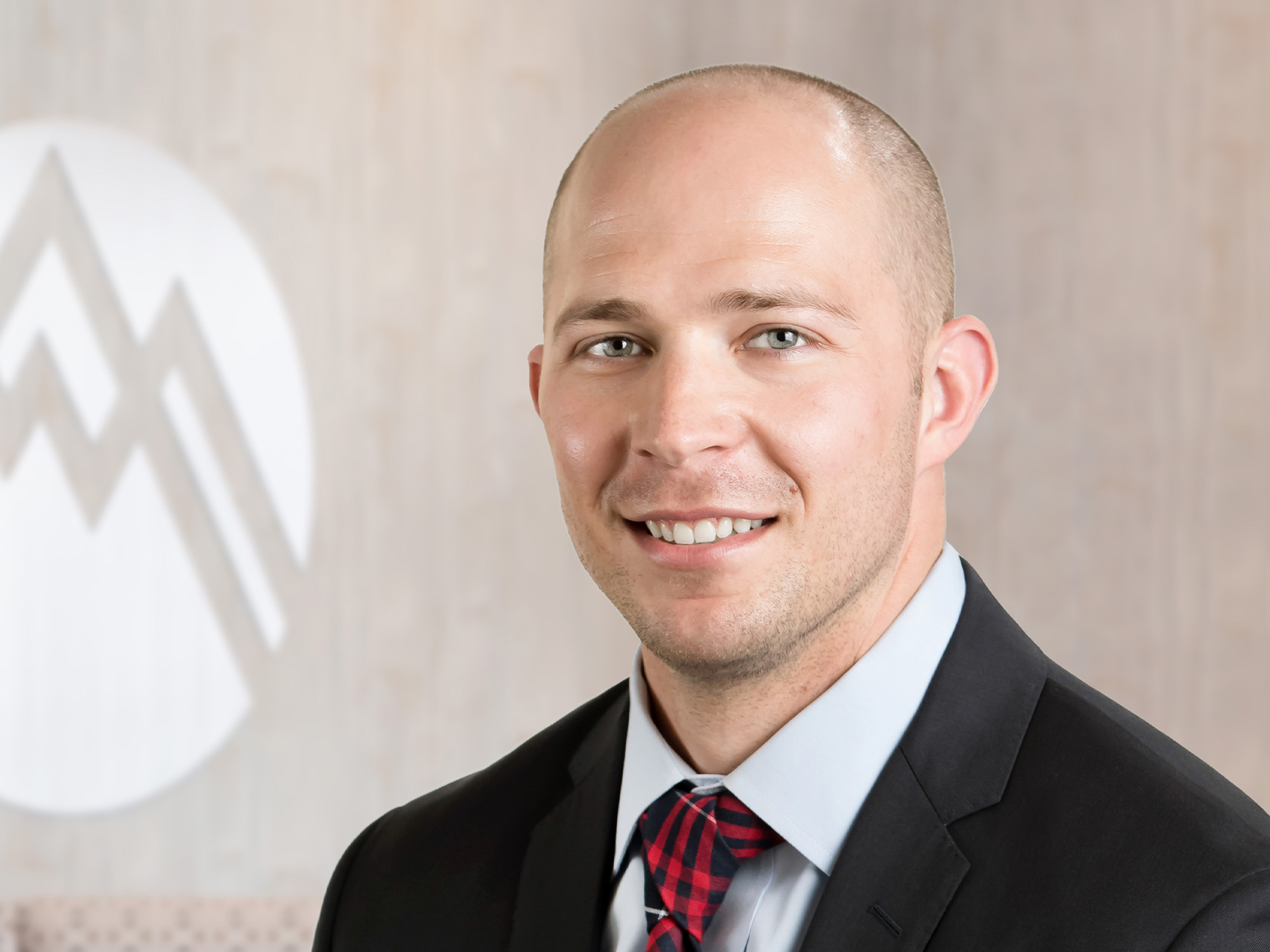Dr. Wahlquist explains that surgery is only one of many treatments for pain caused by bulging discs.
The spine is a complex structure. When it causes us pain, there are a multitude of potential causes—including bulging discs. Spine surgeon Dr. Trevor Wahlquist describes how discs function in the spine and discusses the conditions that cause discs to bulge. Finally, he explains that although most cases of pain caused by bulging discs are treated nonsurgically, there are specific situations when surgery can provide an excellent outcome.
How discs function in the spine
“The disc is the part of the spine that lives between two bones in the spinal column,” explains Dr. Wahlquist. “Their main job is to act as a shock absorber. They protect the bones by buffering axial compression along the spine. Unfortunately, as we age, our discs can dehydrate. Imagine a dehydrated disc as a water balloon that has lost some of its water. The disc becomes floppy and bulges out from between the bones it is supposed to cushion. Spine problems can begin when bulging discs occur.”
Dr. Wahlquist explains that a dehydrated disc can bulge in one of three places: the front of the spine, the sides of the spine, or into the back of the spine. “When discs bulge at the sides or the front of the spine, the bulge doesn’t bother anything,” he says. “But the spinal nerves run along the back of the spine, encased in a covering called dura. If the disc bulges at the back of the spine, pushing into the dura, it can press on nerves. Irritated nerves frequently trigger pain.”
Conditions that cause bulging discs
“A wide range of conditions can cause bulging discs,” says Dr. Wahlquist. He reviews some of the more common conditions that cause disc damage.
- Degeneration of the disc over time as we age.
- Genetics that predispose our discs to deteriorate.
- Wear and tear from work or extracurricular activities can take a toll on disc health.
- Traumatic injury is another component that can result in disc damage. “You can hurt your disc in a fall or by doing something heroic like trying to lift a car off a child,” notes Dr. Wahlquist. “On the other hand, something as minor as a cough or sneeze sometimes causes a disc to give out.”
Treatment for bulging discs
Not all bulging discs require treatment. “The only time you treat this condition is when it causes back or leg pain,” states Dr. Wahlquist. “Even when a damaged disc does cause pain, there are a number of nonsurgical treatments. At Summit, we believe in responsive treatment to maximize nonoperative management before we even consider surgery. Our nonsurgical treatments include physical therapy, injections, medications, activity modifications, and simply time to heal. We have about a 90 percent success rate treating disc bulges nonoperatively,” he notes. “However, if the pain becomes problematic or does not respond to nonsurgical options within a month or two, we’ll discuss other options.”
Dr. Wahlquist points out that only certain types of disc-generated pain respond well to surgery. “Bulging disc pain is typically nerve pain that runs down the leg,” he explains. “A bulging disc can also cause back pain, and back pain is a challenge. That’s because data tells us that surgery is not an effective treatment for pain in the back. On the other hand, leg pain from a bulging disc responds well to surgery. Surgical treatment of leg pain has a 98 to 99 percent success rate. The success rate for eliminating back pain with surgery is much lower.”
When should surgery be considered for symptoms caused by bulging discs?
“When leg pain can’t be controlled by nonoperative options and becomes so severe that it is interfering with work or other day-to-day activities, it’s time for us to talk about surgery,” says Dr. Wahlquist. “Having uncontrolled pain doesn’t mean you’re going to get spine surgery. It just means that we should talk because you may be a surgical candidate.”
Dr. Wahlquist notes that progressive weakness is another symptom that should expedite a conversation. “If you can’t pick your foot up or if your foot is slapping the ground as you walk, I want you to come in immediately,” he says. “This symptom doesn’t mean we’re going right to surgery, but foot weakness is a red flag. And remember, it may or may not be accompanied by pain. The weakness may manifest as an inability to do a mini squat or to balance on one leg. If you find that you are collapsing down on one leg versus the other, that could be a sign of a disc herniation or bulge that’s higher in the spine. We want to evaluate this without delay.”
What to expect during a surgical evaluation for pain caused by bulging discs
“When you come to see me, I’m going to do a careful evaluation,” says Dr. Wahlquist. “I frequently use injections as both a pain treatment option and a diagnostic tool. When a patient experiences short-term relief from a numbing injection, but no long-term relief, they are a great surgical candidate. On the other hand, if someone experiences no relief at all—short term or long term—then I want to make sure we aren’t missing another problem. In that case, there could be a joint issue or nerve damage in another location. In short, I need to do a little bit more searching in those circumstances.”
What research tells us about surgical outcomes
If Dr. Wahlquist’s evaluation concludes that you are a good surgical candidate, the surgery for bulging discs is a microdiscectomy. “Leg pain caused by a bulging disc has three components: pain, weakness, and numbness or tingling,” says Dr. Wahlquist. “Our success with this surgery is best understood by reviewing results for these three types of pain individually.”
- Improving leg pain. For appropriate candidates, a microdiscectomy has about a 98 to 99 percent success rate in improving leg pain.
- Weakness. Surgery has a 90 to 92 percent success rate in improving any weakness you might have. “We measure weakness outcomes in degrees,” notes Dr. Wahlquist. “Patients may gain back a high percentage of strength. However, the strength in the affected leg may never equal the strength of the other leg. An individual outcome really depends on where the weakness is, how significant it is, and how quickly we can act to treat the condition.”
- Numbness and tingling. This symptom has the least predictable outcome of the three symptoms. A microdiscectomy has about a 50-percent success rate resolving numbness and tingling. “This is because nerves may not be able to fully recover from the damage caused by the bulge pressure,” explains Dr. Wahlquist. “I like to explain that if the nerve is too damaged, your leg is just going to be tingly. Fortunately, if you had to choose which symptom you’d get rid of first, everyone would say pain and then weakness, and then numbness and tingling—in that order.”
Treatment timing matters
“Research tells us that for the best surgical outcome, we need to operate within three months of the onset of leg pain symptoms,” notes Dr. Wahlquist. “At Summit, we can see you without delay and begin treatment with that three-month time frame in mind. We know that moving to surgery within that three-month window, if necessary, is the best way to maximize your outcome. Of course, it’s still possible to do surgery if more than three months have elapsed since symptoms started. But if surgical treatment happens after the three-month period, the outcome is less predictable.”
Summit Orthopedics offers comprehensive spine expertise
Our back specialists diagnose spine problems and design custom treatment plans built on a conservative, nonsurgical approach. Most patients find relief through treatments including guided injections, specialized physical therapy, biofeedback, exercise, activity modification, and medication. When conservative care does not relieve symptoms, our highly skilled surgeons offer proven, evidence-based surgical options. Together with you, we will determine the right course of action.
Start your journey to a healthy spine. Find your spine expert, request an appointment online, or call us at (651) 968–5201 to schedule a spine consultation.
Summit has convenient locations across the Minneapolis-St. Paul metro area, serving Minnesota and western Wisconsin. We have state-of-the-art centers for comprehensive orthopedic care in Eagan, MN, Plymouth, MN, Vadnais Heights, MN, and Woodbury, MN, as well as additional community clinics throughout the metro and southern Minnesota.
More resources for you
- Learn more about a microdiscectomy
- Watch the video: Lumbar Disc Microdiscectomy

